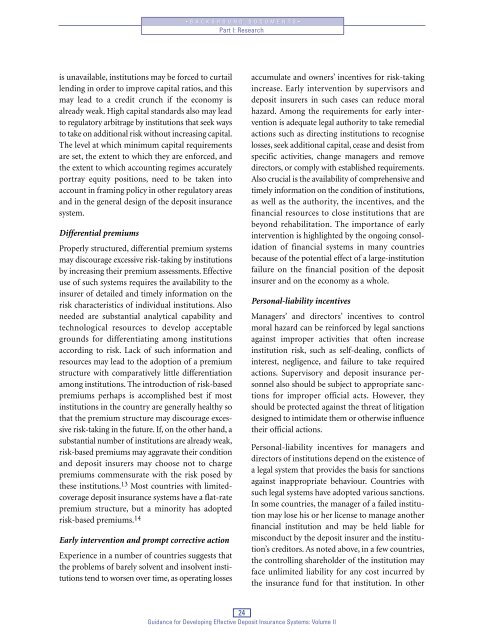Volume II - PDF - International Association of Deposit Insurers
Volume II - PDF - International Association of Deposit Insurers
Volume II - PDF - International Association of Deposit Insurers
- No tags were found...
You also want an ePaper? Increase the reach of your titles
YUMPU automatically turns print PDFs into web optimized ePapers that Google loves.
•BACKGROUND DOCUMENTS•<br />
Part I: Research<br />
is unavailable, institutions may be forced to curtail<br />
lending in order to improve capital ratios, and this<br />
may lead to a credit crunch if the economy is<br />
already weak. High capital standards also may lead<br />
to regulatory arbitrage by institutions that seek ways<br />
to take on additional risk without increasing capital.<br />
The level at which minimum capital requirements<br />
are set, the extent to which they are enforced, and<br />
the extent to which accounting regimes accurately<br />
portray equity positions, need to be taken into<br />
account in framing policy in other regulatory areas<br />
and in the general design <strong>of</strong> the deposit insurance<br />
system.<br />
Differential premiums<br />
Properly structured, differential premium systems<br />
may discourage excessive risk-taking by institutions<br />
by increasing their premium assessments. Effective<br />
use <strong>of</strong> such systems requires the availability to the<br />
insurer <strong>of</strong> detailed and timely information on the<br />
risk characteristics <strong>of</strong> individual institutions. Also<br />
needed are substantial analytical capability and<br />
technological resources to develop acceptable<br />
grounds for differentiating among institutions<br />
according to risk. Lack <strong>of</strong> such information and<br />
resources may lead to the adoption <strong>of</strong> a premium<br />
structure with comparatively little differentiation<br />
among institutions. The introduction <strong>of</strong> risk-based<br />
premiums perhaps is accomplished best if most<br />
institutions in the country are generally healthy so<br />
that the premium structure may discourage excessive<br />
risk-taking in the future. If, on the other hand, a<br />
substantial number <strong>of</strong> institutions are already weak,<br />
risk-based premiums may aggravate their condition<br />
and deposit insurers may choose not to charge<br />
premiums commensurate with the risk posed by<br />
these institutions. 13 Most countries with limitedcoverage<br />
deposit insurance systems have a flat-rate<br />
premium structure, but a minority has adopted<br />
risk-based premiums. 14<br />
Early intervention and prompt corrective action<br />
Experience in a number <strong>of</strong> countries suggests that<br />
the problems <strong>of</strong> barely solvent and insolvent institutions<br />
tend to worsen over time, as operating losses<br />
accumulate and owners’ incentives for risk-taking<br />
increase. Early intervention by supervisors and<br />
deposit insurers in such cases can reduce moral<br />
hazard. Among the requirements for early intervention<br />
is adequate legal authority to take remedial<br />
actions such as directing institutions to recognise<br />
losses, seek additional capital, cease and desist from<br />
specific activities, change managers and remove<br />
directors, or comply with established requirements.<br />
Also crucial is the availability <strong>of</strong> comprehensive and<br />
timely information on the condition <strong>of</strong> institutions,<br />
as well as the authority, the incentives, and the<br />
financial resources to close institutions that are<br />
beyond rehabilitation. The importance <strong>of</strong> early<br />
intervention is highlighted by the ongoing consolidation<br />
<strong>of</strong> financial systems in many countries<br />
because <strong>of</strong> the potential effect <strong>of</strong> a large-institution<br />
failure on the financial position <strong>of</strong> the deposit<br />
insurer and on the economy as a whole.<br />
Personal-liability incentives<br />
Managers’ and directors’ incentives to control<br />
moral hazard can be reinforced by legal sanctions<br />
against improper activities that <strong>of</strong>ten increase<br />
institution risk, such as self-dealing, conflicts <strong>of</strong><br />
interest, negligence, and failure to take required<br />
actions. Supervisory and deposit insurance personnel<br />
also should be subject to appropriate sanctions<br />
for improper <strong>of</strong>ficial acts. However, they<br />
should be protected against the threat <strong>of</strong> litigation<br />
designed to intimidate them or otherwise influence<br />
their <strong>of</strong>ficial actions.<br />
Personal-liability incentives for managers and<br />
directors <strong>of</strong> institutions depend on the existence <strong>of</strong><br />
a legal system that provides the basis for sanctions<br />
against inappropriate behaviour. Countries with<br />
such legal systems have adopted various sanctions.<br />
In some countries, the manager <strong>of</strong> a failed institution<br />
may lose his or her license to manage another<br />
financial institution and may be held liable for<br />
misconduct by the deposit insurer and the institution’s<br />
creditors. As noted above, in a few countries,<br />
the controlling shareholder <strong>of</strong> the institution may<br />
face unlimited liability for any cost incurred by<br />
the insurance fund for that institution. In other<br />
24<br />
Guidance for Developing Effective <strong>Deposit</strong> Insurance Systems: <strong>Volume</strong> <strong>II</strong>
















